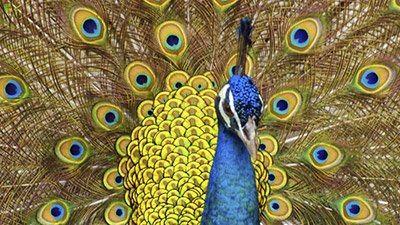
Empathy or Imitation—Do Chimps Yawn Because They Care?
Chimpanzees “empathize” as they mature, but do they really understand?
News Source
- South China Morning Post: “Scientist Finds Contagious Yawning Takes Hold Among Older Chimpanzees”
Did you yawn when you read today’s title? Many people—anywhere from 45 to 60 percent—are susceptible to contagious yawning. Some scientists think contagious yawning is connected to the ability to empathize. And given that evolutionary scientists seek an evolutionary explanation for everything, even morality, animal studies of yawning are used in an attempt to explore the evolutionary underpinnings of human empathy.
While chimps, bonobos, and baboons catch yawns from each other, especially when strong social bonds exist, contagious yawns seem to have no intrinsic survival value, making the evolutionary impetus to select for such behavior enigmatic. By viewing caught yawns as evidence of empathy, however, evolutionary researchers can chalk them up to being a way of communicating cooperation with one’s group and then try to unravel their evolutionary basis along those lines.
Not Just for Primates
The only non-primate animals known to exhibit contagious yawning are budgerigar birds and dogs. And dogs only catch yawns from people, not other dogs—which makes little sense from an evolutionary point of view, but that does not deter evolutionists from recruiting dog yawns as an evolutionary model of mammalian empathy. In fact, until now, dogs were the only animals known to catch yawns from other species.
Evolutionary psychologist Elaine Madsen of Sweden’s Lund University and her team now report that chimpanzees—at least orphaned ones cared for by humans—have entered the ranks of interspecies yawn-catchers. Chimps do take a while to catch on to catching yawns, though. Infant chimps (aged 1 to 4 years) are apparently oblivious to the shared bond forged by yawning when humans yawn. Juvenile chimps (5 to 8 years old), on the other hand, were induced by human yawning to yawn 24 times in 63 attempts; 48% of the 21 juvenile chimps tested yawned.1 Dogs yawn more predictably when their owners yawn, and chimps yawn more in response to chimps they know. These chimps, surprisingly, were not more responsive to familiar humans; in fact, they responded twice as often to human strangers than to familiar people, though the difference was not statistically significant.2

Chimps have now joined dogs as the only animals known to catch yawns from other species. Chimps can also catch yawns from each other, but dogs only catch yawns from humans. Image from South China Morning Post.3
Not fooled by other imitable gestures, the juvenile chimps did not find nose-wiping or mere gaping to be gestures worth mirroring. Does yawning intrinsically exceed the value of wiping your nose for demonstrating solidarity with your neighbor? Apparently it does for chimps. In any case, the chimps’ failure to copy nose-wiping and gaping seems to demonstrate they were not merely copying in “monkey see, monkey do” fashion.
Elaine Madsen, who co-authored the report published in PLOS ONE, says, “The results of the study reflect a general developmental pattern, shared by humans and other animals. Given that contagious yawning may be an empathetic response, the results can also be taken to mean that empathy develops slowly over the first years of a chimpanzee's life.”4 Because humans don’t really catch yawns until age 4, and dogs don’t catch on until about 7 months of age, the researchers suspect this demonstrates that empathy—the motivational cause to which they attribute contagious yawning—is an emotion that one must grow into.
Defining Empathy
Empathy, the authors note, comes in two forms—affective empathy and cognitive empathy. Affective empathy involves, as politicians say, the ability to “feel your pain.” Evolutionists consider this a more primitive sort of empathy that “derives from a phylogenetically old social contagion system, whereby one is viscerally affected by another’s emotional or arousal state.”5 Affective empathy is an automatic, gut-level transfer of emotions and the behaviors that express them from one individual to another.
Cognitive empathy, however, is the ability to not only feel but also understand your pain. Cognitive empathy requires the ability to imagine another individual’s emotional experience, to see things from someone else’s perspective. Drawing on the terminology of evolutionary psychologist and primatologist Frans B. de Waal, the authors point out that cognitive empathy, which de Waal calls “empathetic perspective-taking,”6 is of greater significance as a more evolutionarily advanced state.
Analysis of the similarity of contagious yawning in their chimpanzees and in dogs led Madsen’s team to conclude that there isn’t any evidence that cognitive empathy is involved in either’s behavior. Thus, while the ability to catch yawns may represent some sort of empathy, they are not convinced that any real understanding is going on.7 Madsen says, “I think we're talking more about affective empathy. It's the kind of empathy where, instead of thinking your way into how someone else might be experiencing the world or feeling, you just feel it. Like when someone cuts their finger you feel sick in your stomach.”
Affective empathy is nevertheless seen as a developmental and therefore an evolutionary prerequisite to cognitive empathy. Madsen writes, “Overall, the existence of CY [contagious yawning] in non-human species, and the development of CY in humans and other species, is consistent with the notion that the development of affective empathy, and an emerging capacity for perspective-taking (as well as increased attention to and improvement in the identification of others’ affective states) is sufficient to explain the distribution of yawn contagion, ontogenetically and phylogenetically.”8
There is evidence that as the brain of a mammalian animal or a young child develops, “mirror neuron networks may be recruited for yawn contagion.”9 Thus the ability to catch yawns may be explained neurologically as an extension of an imitative ability that improves with age. Evolutionists generally believe that evolution across time and increasingly complex species (“phylogenetically”) mirrors what is seen in development (“ontogenetically”). This is an extension of “recapitulation theory,” which though insupportable by scientific observations is a very convenient concept in the evolutionary toolkit.
Last week we discussed whether “empathetic” behavior in bonobos has anything to do with the origin of human empathy, ethics, and morality—as Frans de Waal maintains that it does. De Waal considers primate emotions to be a valid window into humanity’s ethical evolutionary past.
More Than Meets the Eye?
Common designs are the expected result of having a common Designer and do not demonstrate either convergent evolution, common evolutionary ancestry, or an evolutionary basis for morality.
Anthropomorphizing presumptions—in and of themselves—are no more significant than what plenty of pet owners do every day, but they aren’t “science.” Evolutionary psychologist Richard Byrne, commenting on de Waal’s study of consoling behavior in bonobos, has pointed out that “consolation” implies actual knowledge of what is going on in the animals’ heads, something that is not subject to scientific observation. The authors of the chimpanzee yawning study refrained from claiming the animals were thinking anything. They compared contagious canine and chimp yawners and explored possible reasons for their differences. Nevertheless, the trend among evolutionists is to consider this sort of information a way to gain insight into the evolution of human morality. Thus, these authors simply attribute contagious yawns to the more evolutionarily “primitive” sort of empathy—affective empathy.
Evolutionists generally assume that similar behaviors in different species need to be explained in evolutionary terms. Some have suggested that contagious yawns are rooted in maintaining communication of alertness among social creatures—and they may be. Some suggest that yawns among primates and humans help regulate brain temperature in the sites associated with drowsiness—and they may be. But similar behaviors do not provide evidence for evolution any more than similar anatomical features do. Common designs are the expected result of having a common Designer and do not demonstrate either convergent evolution, common evolutionary ancestry, or an evolutionary basis for morality. On the contrary, learning more about the neurological basis for contagious yawning may give us a bit more insight into our Creator’s designs.
Our bodies, minds, morals, and spirit are not the result of millions of years of molecules-to-man evolution. Human morality is rooted in our origin as created beings made in the image of God. Humans, not animals, were made in the image of God. Humans, not animals bear the moral responsibility and sin guilt for rebellion against their Creator. We naturally tend to anthropomorphically interpret animal behaviors in terms of what we ourselves feel and understand, but to suggest that instances of animal empathy demonstrate the evolutionary underpinnings of human morality is neither scientifically verifiable nor valid.
Ascribing human moral standards and motives to animals reinforces the false evolutionary faith that humans are merely highly evolved animals who will never have to face the holy judgment of God. As we learn more about the creatures in the world God made, we would do well to glorify the Creator’s handiwork and trust the Creator’s assessment of our true moral nature—guilty of sin and need of the redemption freely available to all through Jesus Christ.
Further Reading
- Do Even-tempered Empathetic Bonobos Reflect Human Evolutionary History?
- Did the Altruistic "Snuggle for Survival" Help Humans Evolve?
- Empathy Study and Evolution
- Easy-Going Ape Joins Genome Club
- Does Your Dog Yawn Because He Cares?
For More Information: Get Answers
Remember, if you see a news story that might merit some attention, let us know about it! (Note: if the story originates from the Associated Press, FOX News, MSNBC, the New York Times, or another major national media outlet, we will most likely have already heard about it.) And thanks to all of our readers who have submitted great news tips to us. If you didn’t catch all the latest News to Know, why not take a look to see what you’ve missed?
(Please note that links will take you directly to the source. Answers in Genesis is not responsible for content on the websites to which we refer. For more information, please see our Privacy Policy.)
Footnotes
- Elainie Alenkær Madsen et al., “Chimpanzees Show a Developmental Increase in Susceptibility to Contagious Yawning: A Test of the Effect of Ontogeny and Emotional Closeness on Yawn Contagion,” PLoS ONE 8, no. 10 (October 16, 2013): e76266, doi:10.1371/journal.pone.0076266.
- Ibid.
- “Scientist Finds Contagious Yawning Takes Hold Among Older Chimpanzees,” South China Morning Post, October 20, 2013, http://www.scmp.com/lifestyle/technology/article/1335334/scientist-finds-contagious-yawning-takes-hold-among-older.
- Public Library of Science, “As Chimpanzees Grow, So Does Yawn Contagion,” ScienceDaily, October 16, 2013, http://www.sciencedaily.com/releases/2013/10/131016213221.htm.
- Madsen et al., “Chimpanzees Show a Developmental Increase in Susceptibility to Contagious Yawning.”
- Ibid.
- Ibid.
- Ibid.
- Ibid.

Answers in Genesis is an apologetics ministry, dedicated to helping Christians defend their faith and proclaim the good news of Jesus Christ.
- Customer Service 800.778.3390
- Available Monday–Friday | 9 AM–5 PM ET
- © 2025 Answers in Genesis



